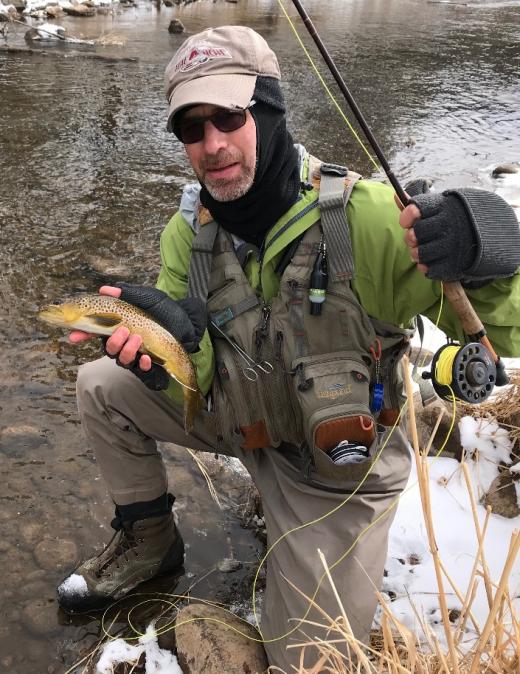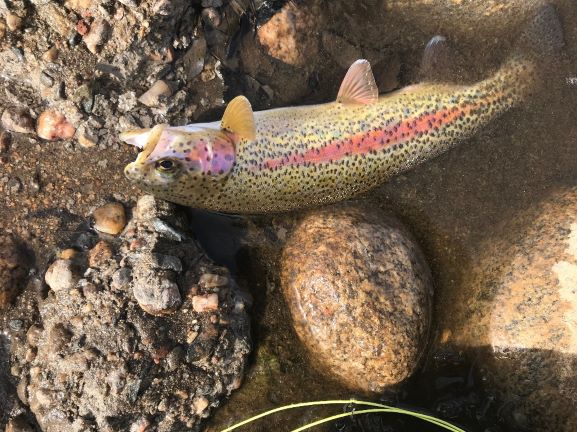Rig for Success—Dry-Dropper-Anchor
Sitting on an ice shelf on the bank, contemplating what to try next, I could hear someone approaching from downstream. The water was so low and clear, I knew as they passed it would be another ten minutes before the run calmed down. As a result, I had plenty of time to consider my next move on these spooky fish. “Would you mind if I took your picture? My dad would be so jealous!” came an inquiry from the hiker. “Your dad would be jealous of a guy sitting in a snow bank freezing?” I joked. “No, he’d be jealous that you’re fishing in the middle of winter. He lives in Virginia and their only option is ice fishing or wait till spring.”
Well, that response put things in perspective and changed my entire attitude. Until then, the morning had been a little disappointing. The low water and bright sky were making it nearly impossible to present my egg pattern, which I just knew would work, without spoking every fish in sight. This college student from CU had just reminded me of my privileged situation. Go Buffs and thank goodness for living in Colorado. Time to take what the conditions are giving me, go back to basics, and most importantly enjoy my precious time on the water!
Ok, the fish aren’t rising, I can’t throw anything with weight or with an indicator, and I can’t see well enough to detect a subtle take on a tiny subsurface midge presentation. Thanks to the water treatment plant a short walk upstream, this is the only water open unless I want to fight the crowd below the dam. However, the water is near freezing so the fish are slow and lethargic. Yes, I had the idea that an egg pattern bouncing along the bottom would raise fish, and maybe even some bigger ones. Unfortunately, eggs are off the menu today due to the conditions. Next, with the water clarity and lack of depth, stealth is in order. I am going to have to stay low, make delicate casts, cover water from my side out, and make sure the fish don’t know I’m around.
One of my favorite rigs the rest of the year is a dry-dropper-anchor combination. The setup consistently connects with lots of fish and allows me to fish most of the water column. There are four keys to success with this approach. First, match the length of the tippet from the dry to the anchor fly with the approximate depth of the water. The result is a tasty morsel on the surface, an emerging look in the middle, and some meat near the bottom that doesn’t hang up constantly.
If water depth changes, add or remove tippet from the anchor fly section. The connections can be made either tippet end to eye and then hook bend to eye, or connect the tippet sections with a blood knot and tie the dry and dropper to the upside tag end. The second option has more potential to tangle, has more line around the flies, and may slightly delay the detection of a strike. However, the first option can create some missed hook sets, especially on the dry, due to the linear nature of the setup. The second key is to coordinate the buoyancy of the dry with the weight of the dropper and anchor. Too much weight and your dry sinks too early. Too little weight, and you’ll run the risk of missing takes, which brings me to the third and fourth keys. Third, concentrate on casting with a wide loop. You don’t have to “chuck and duck,” but a tight looped dry fly cast will leave your flies in a tangled mess. Fourth, make your presentations so the dry rides downstream of the subsurface flies. Cast upstream, keep as much of the fly line off the water as possible, and mend as the presentation progresses to insure alignment and a drag free drift.
So where did I end up after the student passed? I tied on a size 18, poly-winged, parachute Adams with a size 20, black, bead head pheasant tail, and then a size 22 black sparkle midge. Since the water was so low, the dropper was only about six inches from the dry and the midge only another five inches down. I got on my knees to keep my profile low, and made a looping, delicate reach cast to kick the flies out away from the fly line about two feet off the bank directly upstream. The flies settled, drifted a few feet and the dry sank indicating either a strike or bottom. Luckily for me, the slight shaking tension on the rod indicated the former. A beautiful Big Thompson Rainbow Trout set the tone for the remainder of the afternoon.



